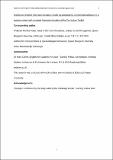Files in this item
Explicit and implicit internationalisation : exploring perspectives on internationalisation in a business school with a revised internationalisation of the Curriculum Toolkit
Item metadata
| dc.contributor.author | Foster, Monika | |
| dc.contributor.author | Carver, Mark | |
| dc.date.accessioned | 2019-02-22T00:33:45Z | |
| dc.date.available | 2019-02-22T00:33:45Z | |
| dc.date.issued | 2018-07 | |
| dc.identifier | 252297074 | |
| dc.identifier | 337ec61f-a91a-4bc1-bb26-0ab31ce116d0 | |
| dc.identifier | 85042292145 | |
| dc.identifier | 000437383800001 | |
| dc.identifier.citation | Foster , M & Carver , M 2018 , ' Explicit and implicit internationalisation : exploring perspectives on internationalisation in a business school with a revised internationalisation of the Curriculum Toolkit ' , International Journal of Management Education , vol. 16 , no. 2 , pp. 143-153 . https://doi.org/10.1016/j.ijme.2018.02.002 | en |
| dc.identifier.issn | 1472-8117 | |
| dc.identifier.other | ORCID: /0000-0003-4393-8915/work/42023946 | |
| dc.identifier.uri | https://hdl.handle.net/10023/17130 | |
| dc.description | The paper is informed by the study aided by the Edinburgh Napier Teaching Fellow fund. | en |
| dc.description.abstract | Business and Management Schools have long been at the forefront of internationalisation, realising that international perspectives are crucial in any business environment. Business Schools compete globally for the best staff and students, seeing them more as assets than customers. As a result, internationalisation is infused throughout the university life and its programmes. However, internationalisation in its practical aspects can be understood differently depending on how subtly internationalisation is infused throughout a programme and how effectively it engages with inclusive pedagogy rather than just curriculum content. This study explores what internationalisation looks and feels like in practice on four programmes in a business school according to students and faculty using a reflective toolkit. What emerges is a clear picture of agreement among students about explicit aspects of internationalisation, such as case studies or considering the views of different nationalities represented by their peers. However, it is only staff and a few students who recognise more tacit forms of internationalisation. This study highlights the potential for internationalisation and recommends adaptations to a reflective toolkit to further facilitate dialogue between staff and students. It is also argued that discussing examples is valuable for students, particularly for articulating the benefits of internationalisation. | |
| dc.format.extent | 438567 | |
| dc.language.iso | eng | |
| dc.relation.ispartof | International Journal of Management Education | en |
| dc.subject | Internationalisation of the curriculum | en |
| dc.subject | Staff and student perspectives | en |
| dc.subject | Business schools | en |
| dc.subject | Globalisation | en |
| dc.subject | Survey tool | en |
| dc.subject | HD28 Management. Industrial Management | en |
| dc.subject | LB2300 Higher Education | en |
| dc.subject | Business and International Management | en |
| dc.subject | Education | en |
| dc.subject | DAS | en |
| dc.subject.lcc | HD28 | en |
| dc.subject.lcc | LB2300 | en |
| dc.title | Explicit and implicit internationalisation : exploring perspectives on internationalisation in a business school with a revised internationalisation of the Curriculum Toolkit | en |
| dc.type | Journal article | en |
| dc.contributor.institution | University of St Andrews. University of St Andrews | en |
| dc.contributor.institution | University of St Andrews. International Education Institute | en |
| dc.identifier.doi | https://doi.org/10.1016/j.ijme.2018.02.002 | |
| dc.description.status | Peer reviewed | en |
| dc.date.embargoedUntil | 2019-02-22 |
This item appears in the following Collection(s)
Items in the St Andrews Research Repository are protected by copyright, with all rights reserved, unless otherwise indicated.

